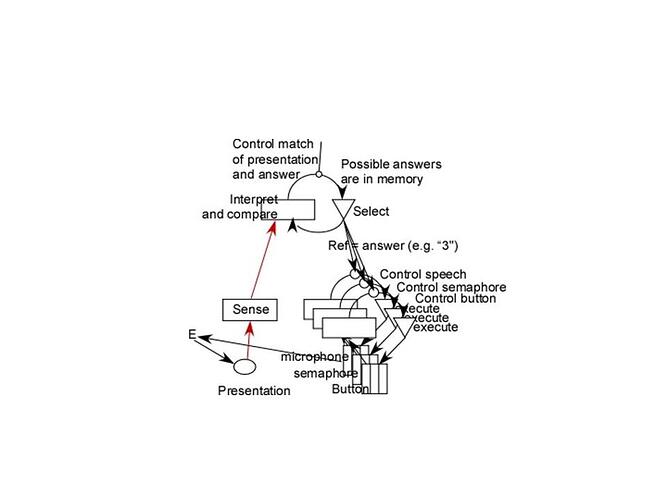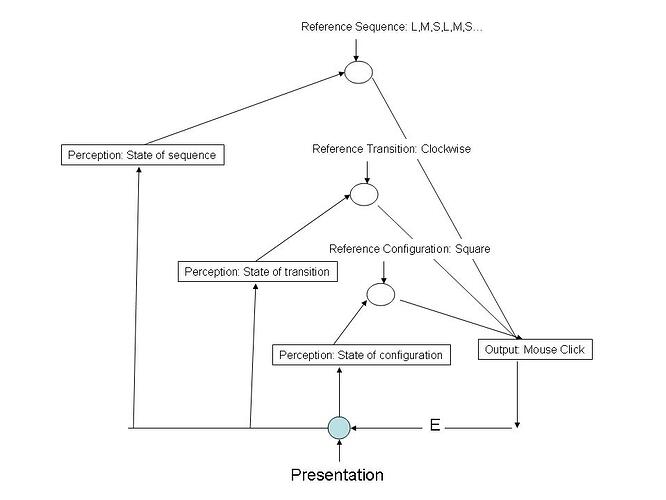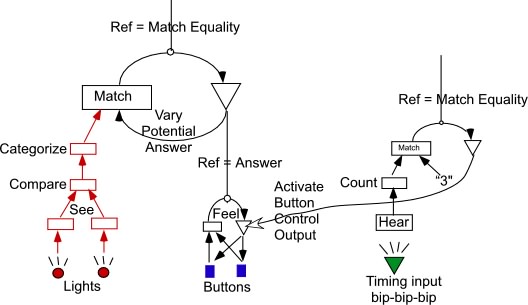[From Bill Powers (2009.02.27.1105 MST)]
[Martin Taylor
2009.02.27.09.57]
[From Rick Marken (2009.02.26.1800)]
> > But it {the "presentation] is combined (via E) with the subject's
> > output and
> > enters the perceptual function that turns it into the perception that is
> > controlled, which must include the tones and the button press, because
> > that is what the subject does seem to control (when the light precedes
> > the final tone by enough time).
[Martin] Comment (1) applies.
[Rick] Yes, that's the way I think of it too; the output of the
perceptual
function (which takes the "presentation" as the input) is a
scalar
variable, the magnitude of which indicates the state of an event
perceived in the bips, lights, and presses that are the inputs to the
perceptual function. I see it kind of like this:
bip
bip
bip ---> | P| --->
p (state of bip...bip...light...bip/press event)
light
press
The sensed values of the environmental events on the left are the
inputs to the perceptual function, P, which is a neural network that
computes the value of a perceptual variable, p. The value of p
indicates whether the event is bip...bip...right light...bip/right
press or bip...bip...left light...bip/left press (if it's either one
of those assume that P computes the value 20 for p) or whether the
event is bip...bip...right light...bip/left press or bip...bip...left
light...bip/right press (if it's either one of those assume that P
computes the value 0 for p).
[Martin] I don’t see control of p in this. I see control of a button
press. I grant that this is one of the components of your p. But at the
time of the button press, there is no more bip, so p has a different
value, and depending on when the third bip occurs relative to the light
onset, p will have yet another value – all of which must be countered by
the choice of pushing left or pushing right. It just doesn’t
wash.
[WTP] I’m very pleased to see you, Martin and Rick, engaging in this
exploration, which is what it is very much in the MOL sense. You are
examining your perceptions of a complex situation and seeing its elements
all mixed together at many levels, and trying to sort them out much as
Bob Clark and Kirk Sattley and I were doing 50-odd years ago. What you
are doing in the excerpt above is noticing different aspects of the
situation – meaning variables at different levels, as well as the same
level – and for the moment disagreeing because of focusing on different
but coexisting levels. Martin sees no control of p in the relationship
between bips and button presses because he is looking at the
configuration level instant by instant, while Rick is looking at that
relationship as a different perception being controlled over a long
period of time, and not seeing what he could see, which is that the
button-press is also being controlled at a lower level. You are both
right, I believe, but as you continue to work this out you will either
come to the same conclusions I reached with Bob Clark, or you will see
something different, and either outcome will be worth discovering. The
important thing is to be discussing and pointing out experiences, rather
than arguing only in terms of what fits the theory and what doesn’t. If
you stick to descriptions of what you are in fact experiencing (not what
you ought to be experiencing) you will find out what is actually the
case. I do believe it is there to be seen.
I see the button as a configuration of sensations. I see a bip as a very
minimal configuration of sensations. At the configuration level, control
systems work strictly in present time. There is no sequence of bips,
there is no “pressing” of a button, there is no relationship
between a bip and a press, nor is there ever any change in a bip or a
press. There is only the state of a bip and the state of a press, and
whatever error there is if there’s a reference condition. The bip happens
far too fast (we can say from a different level) to be controlled, but
the button-finger combination may be in a state different from the
reference state, which (theoretically, not experientially) is accompanied
by an error that accounts for the current level of muscle force (and its
derivatives) in the eternal present. At the configuration level there is
a perception, and an error, and an effort, and that is all. At that level
Martin is right: there is a button and a finger and pressing and perhaps
a bip and a light or perhaps not.
At the transition level we begin to notice the ongoing changes. The
pressure in the button/fingertip is steady or increasing, a bip may or
may not suddenly be appearing, a light may or may not be suddenly
increasing in intensity.
At the next level, the string of bips may be under way with the time
between the first two yielding a sense of an interval beginning and
ending; an Event. That interval signal may be stored in memory and be
used as a reference for the next interval. A finger may or may not be
feeling the increase in pressure that we label, at a higher level, a
“press.” The reference signal may or may not be calling for
such a perception of increased pressing.
At the relationship level, the increase in fingertip pressure is supposed
to be in the correct temporal relationship with the occurrance of the
next bip. On the first two bips this relationship requires the finger to
be held away from the button to create a “bip and no press”
relationship, and an instant before the third bip occurs the reference
level for that relationship may change so now the fingertip pressure must
increase at the same instant the next bip occurs. At a higher level, this
change in reference is determined as a logical condition: if and only if
the second bip has occurred and a light is on, the finger near the button
associated with the light is to increase its pressure at the time of the
third bip. Over a long series of trials, the time of the change in the
pressing event reference level in relation to the second bip event, when
required, is reorganized – adjusted slowly until synchronism is achieved
(a reaction time of zero every time this is called for).
At the category level, the events become logical variables: they have
occurred or they have not occurred. Each different event is represented
by a different logical variable. The events are first bip, second bip,
third bip, light onset, relationship of bip to finger-press onset (the
only controllable relationship), and relationship of light onset to bip.
There may be duplications of some of these variables for the two
light-button sets.
At the sequence level, we have bip, bip-bip, bip-bip-bip, bip-bip-light
(or possibly bip-light or even light-bip), and bip-bip-(press/bip). Only
the last sequence is controllable.
At the logic level we have the condition already described:
<------ reference condition is TRUE
------> <reference
(bip1-bip2-light OR bip1-light OR light-bip1) —>
bip-bip-(press/bip) (ref)
The only variable that can be altered by the subject to control the above
sequence is the state of the press, which is accomplished by varying the
time when the reference level for the press relationship to the next bip
is changed. Then the reference level for the transition of the finger
pressure from low to high is set to a nonzero value, and so on down to
the act itself.
I know that this leaves out some things I haven’t noticed or didn’t know
what to do with, but that’s what I find when I imagine doing this
experiment, and do the imagining from the level where theoreticians
think, wherever that is.
[Rick]
Yes, exactly. The "Interpret and Compare" function has
multiple inputs
(sensory representations of all those bips, lights and presses). So
we're in agreement?
[Martin] Very far from it.
I see neither value in, nor justification for, combining into one scalar
variable three completely different perceptions that have different
functions in control: a perception of time that has as input an auditory
sensation, a perception of location that has a visual sensation as input,
and a perception of moving a chosen finger to a button, which has haptic
or kinaesthetic sensation as input. It’s much the same as putting in one
scalar variable the meaning of what one is reading, the feeling of the
book cover in one’s hands, the music in the background, and the smell of
dinner cooking…
I think this disagreement is primarily a difference is the level of
control one is thinking about. All the levels are operating at the same
time, and they are physically distinct from each other; each level knows
only what it perceives and controls, and knows nothing of what is
happening at lower or higher levels. Unfortunately for understanding, we
consciously experience most of these processes as if they were all
projected into the same plane so we lose the dimension we refer to as
“level”. We have to attend to the details carefully so we can
sort out what has to happen before what else happens, and then how the
result is controlled, if it is.
I am half-reminded of many little illuminations that happened back when I
was first going through this sort of thing, one being the idea that one
level knows nothing of other levels. Another is a principle to the effect
that one has to find ALL the levels in order for each step to appear
necessary rather than arbitrary. There seems to be nothing left out when
we see that change arises from different states of configurations, with
no intermediate step being necessary: the change in the value of X simply
IS (X2 - X1). Ideally, we would see the progression from each
level to the one above it as equally compelling and minimal.
But perhaps the biggest illumination was simply concluding that nothing
important is hidden: if you look, you can see what is there.
I hope both of you will continue with this. My word on it is not the last
word, and being objectively or logically right is not the point. The
point is to observe what is actually there and tease it apart into levels
as well as one can. When you succeed in seeing what is really there it’s
possible that you will find that others can agree that they see the same
thing, as near as can be determined. If there is agreement, then maybe we
can claim to have discovered something that is a common property of homo
sapiens.
Best,
Bill P.



